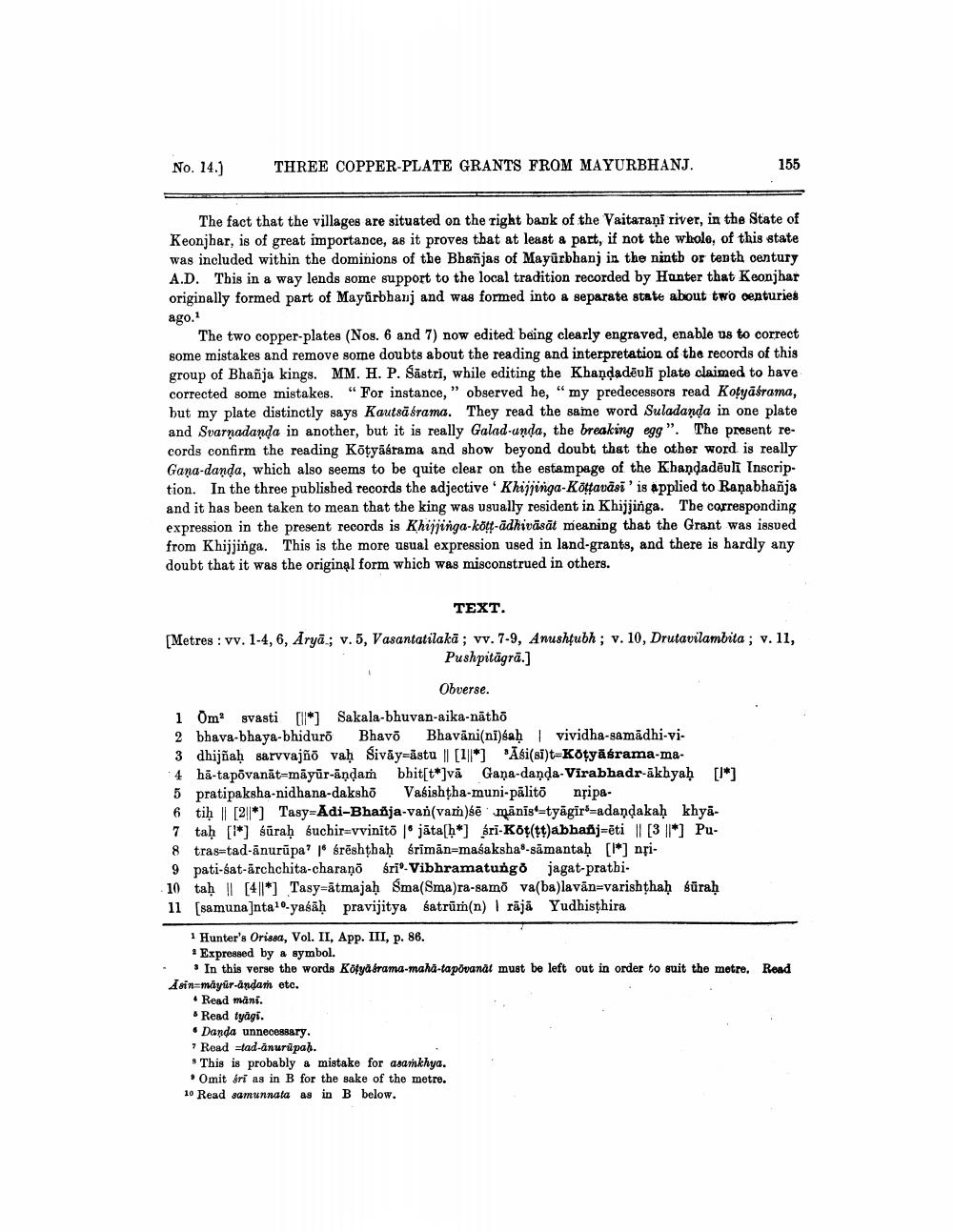________________
No. 14.)
THREE COPPER-PLATE GRANTS FROM MAYURBHANJ.
155
The fact that the villages are situated on the right bank of the Vaitarani river, in the State of Keonjhar, is of great importance, as it proves that at least a part, if not the whole of this state was included within the dominions of the Bhañjas of Mayürbhanj in the nintb or tenth oentury A.D. This in a way lends some support to the local tradition recorded by Hunter that Keonjhar originally formed part of Mayürbhanj and was formed into a separate state about two oenturies ago. 1
The two copper-plates (Nos. 6 and 7) now edited being clearly engraved, enable us to correct some mistakes and remove some doubts about the reading and interpretation of the records of this group of Bhañja kings. MM. H. P. Šāstri, while editing the Khandadēuli plate claimed to bave corrected some mistakes. “For instance,” observed he,"my predecessors read Kotyäsrama, but my plate distinctly says Kautsäsrama. They read the same word Suladanda in one plate and Svarnadanda in another, but it is really Galad-unda, the breaking egg". The present records confirm the reading Kötyäsrama and show beyond doubt that the other word is really Gana-danda, which also seems to be quite clear on the estampage of the Khandadöult Inscription. In the three published records the adjective 'Khijjinga-Koffavāsi' is applied to Ranabhañja and it has been taken to mean that the king was usually resident in Khijjinga. The corresponding expression in the present records is Khijjinga-kött-ādhivāsāt meaning that the Grant was issued from Khijjinga. This is the more usual expression used in land-grants, and there is hardly any doubt that it was the original form which was misconstrued in others.
TEXT.
[Metres : vv. 1-4, 6, Aryā; v. 5, Vasantatilakā; vv. 7-9, Anushțubh ; v. 10, Drutavilambita ; v. 11,
Pushpitāgrā.]
Obverse. 1 Omogvasti [*] Sakala-bhuvan-aika-nātho 2 bhava-bhaya-bhiduro Bhavo Bhavāni(nī)śaḥ | vividha-samādhi-vi3 dhijñaḥ sarvvajño vaḥ śivāy=āstu || [11] Āsi(si)t=Kötyäsrama-ma4 hā-tapovanāt māyür-āņdam bhit[t*]vā Gana-danda-Virabhadr-akhyaḥ [1*] 5 pratipaksha-nidhana-dakshö Vaśishtha-muni-pālito npipa6 tiḥ || [2016] Tasy-Adi-Bhaõja-van(vam)śē mānise-tyāgiro-adandakaḥ khya7 taḥ [*] śūraḥ śuchir=vvinito jāta[b*) sri-Kot(tt)abhanj=ēti || [3 II] Pu8 tras-tad-anurūpa? | brēshthaḥ śrimān=masaksha-samanta) [1*] nfi. 9 pati-sat-archchita-charaņo sri - Vibhramatungo jagat-prathi. 10 tah || [4||") Tasyatmajaḥ Sma(Sma)ra-samo va(ba)lavån varishthah surah 11 [samunajnta10.yabāḥ pravijitya satrum(n) räjä Yudhisthira
Hunter's Orissa, Vol. II, App. III, p. 86. * Expressed by a symbol.
• In this verse the words Kolyasrama-maha-tapovanät must be left out in order to suit the metre. Read Asin=mayür-andar etc.
. Read mani.
Read tyagi. • Danda unnecessary.
Read =tad-anurūpah. * This is probably a mistake for asankhya. . Omit eri as in B for the sake of the metre. 10 Read samunnata as in B below.




